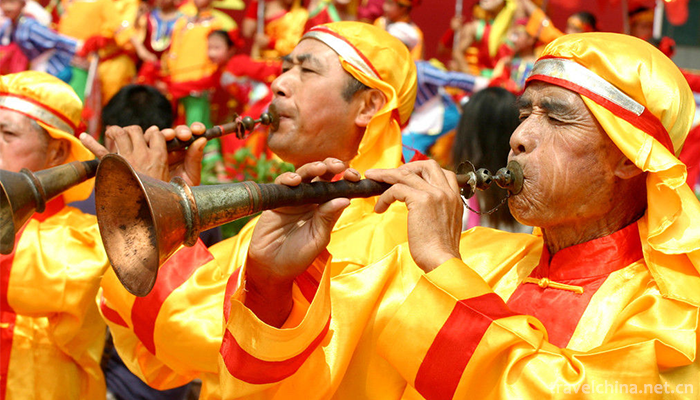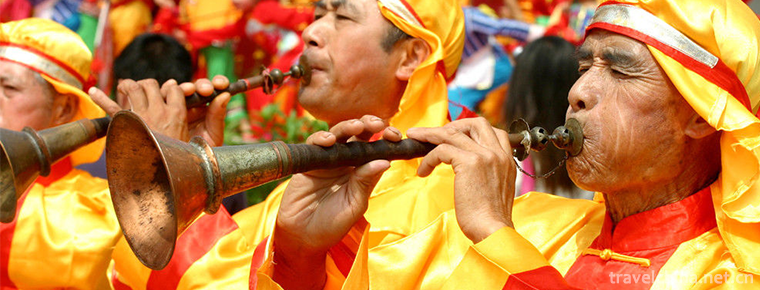Suona Art
Suona Art
Suona art is a manifestation of traditional Chinese folk culture. In 2006, Qinyang City of Henan Province and Qingyang City of Gansu Province applied for intangible cultural heritage. Its basic musical instrument, Suona, commonly known as "trumpet", is a kind of folk musical instrument widely circulated in various parts of China. According to different classification standards, it can be divided into different types, with high and loud pronunciation. In the past, it was mostly used in folk songs, Yangko concerts, drum music classes, local opera and opera accompaniment. Through continuous development, it has enriched the playing skills and improved the expressiveness, and has become a unique solo instrument, which is used for National Orchestra Ensemble or opera, singing and dancing accompaniment.
On May 20, 2006, Suona Art was approved by the State Council and listed in the first batch of national intangible cultural heritage list.
historical origin
The original Suona was a musical instrument spread in Persia and Arabia. Even the name Suona was also a transliteration of Surn Suona in ancient Persia. Suona appeared in China in about the third century A.D. and the music frescoes in Cave 38 of Kizil Grottoes in Baicheng, Xinjiang, have played the image of Suona. In the Jin and Yuan Dynasties more than 700 years ago, it spread to the Central Plains of China. By the Ming Dynasty, Suona had been recorded in ancient books: Suona had been widely used in China during the Zhengde Period of the Ming Dynasty (1506-1521). Qi Jiguang (1527-1587), a military general of the Ming Dynasty, once used Suona in military music. In his Ji Xiao Xin Shu o Wu Bei Zhi, he said, "Whoever plays the flute is blowing the suona. "More detailed records can be found in the edition of Sancai Picture Society (1607) by Wang Kui of the Ming Dynasty. Suona is made of trumpets and seven holes. Copper is used at the beginning and end, while wood is used for pipes. I don't know what generation it originated from, but it's also a pleasure to be in the army. Nowadays, it is widely used among the people. "The Ming Dynasty's King Pan Chao Tianzi Yong Horn" is the best article describing Suona: "Horn, Suona, small tune, big tune. Official ships and ships are in chaos, depending on you to raise your price. The army listened to the military worries, the people listened to the fear of the people, where to distinguish official is true and false? Seeing it blow over the house and hurt the house, the goose flew out of the water. "In the late Ming Dynasty, Suona played an important role in opera music to accompany the singing and play the playing cards. In folk instrumental music based on opera music, Suona has become an indispensable instrument. Legend has it that Zhu Zai, the imperial clan of Ming Dynasty, developed "Eye Tube" on the basis of Suona Eight-tone Hole, which made great contributions to the development of Chinese national wind music. It is said that he once founded the "Golden Drum Club" in Jiufeng Temple. On September 23 of the lunar calendar, Suona classes from all over the country gathered here. During the late Ming and early Qing Dynasties, there were "Tongyue Club" and "Jiajiaban", and from the Qing Dynasty to the Republic of China, there were "Majin Class", "Mao Dan Class" and "Galaxy Class" and other Suona performance organizations, which had a great influence in the local area. The proverbs of "big flowery sedan chair, Majin blowing, Majin not blowing or not marrying" and "the arrival of girlfriends and sons-in-law, Mao Dan not blowing sedan chair" in Qinyang reflect the influence of these Suonaban classes. According to the regional and artistic style, the Suona in Qinyang can be divided into four major schools as a whole. Qinhe River as the boundary, divided into Qinbei School and Qinnan School; Qinbei School to Zhang Jia, He Jia, Ma Jia as the representative, Qinnan School to Jia Jia as the representative. Its prosperity can be seen here. Under the influence of the four major artists, the Suona Ban Club and the artists in Qinyang are increasing in scale and number. From the founding of New China to the 1980s, there were more than 30 Suona classes in Qinyang. More than 400 people played Suona, presenting the situation that there were Suona in villages and villages. According to incomplete statistics, more than 300 pieces of music were played by Suona in Qinyang. In modern and contemporary folklore and artistic life, on the basis of inheriting tradition, folk artists have created some new and representative songs, such as Ode to Hometown, Jiufeng Love Story and Qinyang Spring. In December 1997, Qinyang City was awarded the honorary title of "Hometown of Henan Folk Art" by Henan Provincial Culture Department, and later named "Hometown of Chinese Folk Art" by the Ministry of Culture.
Representative Works
"Dressed in Red Flowers" and so on
Inheritance Significance
Xifeng Suona in Qingyang is a folk percussion music, also known as drumming music, which is mainly played by Suona. Through continuous processing and inheritance of generational artists, Xifeng Suona has become a unique kind of folk music in our country with its numerous music cards, huge performing team, rich folk content and strong local characteristics. It centers on Xifeng and distributes in some towns and townships of Qingcheng County, Huanxian County, Heshui County, Ningxian County, Zhengning County and Zhenyuan County. There are 31 Suona Ban clubs and 286 employees in Xifeng District alone. The performances of this kind of music are composed of "big pieces" and "small pieces". Ordinary musicians can master more than two instruments and can move them freely without changing their personnel. Qingyang Suona Opera has abundant cards, simple charm, self-contained system and unique style. There are more than 1200 pieces of traditional music collected after census, and 496 pieces of them are compiled into "Qingyang Folk Instrumental Music Integration". These cards can be divided into three categories: traditional opera, folk song variation and local opera, and the representative repertoire is "Dressed with Red Flowers".
The cultural value of Qingyang Suona is not only manifested in the uniqueness of music, but also in the extension of its content. For example, "Running Newspaper" is one of the manifestations with rich connotations. It greatly exerts the artist's improvisational creative ability through oral transmission, fully demonstrates the wisdom of the working people, and plays an important role in inheriting and carrying forward traditional virtues and enhancing social cohesion. However, this unique music species is in a serious state of endangerment, so it is urgent to take corresponding rescue and protection measures.


-
1.Zhengzhou Xiao Ji stewed noodles
Zhengzhou Xiao Ji stewed noodles,Xiao Honghe, the founder of Xiao Ji Yanmian, was a master of Yifumian at Changchun State-owned Hotel in Zhengzhou.
Time 2018-11-26 -
2.Free and unfettered hu hot soup
The authentic Xiaoyao Town Hu Hot Soup, produced in Xiaoyao Town, Xihua County, Zhoukou City, Henan Province, is a famous snack in China
Time 2018-11-26 -
3.Nanxi Mountain Scenic Area Guilin
Guilin Nanxi Mountain Scenic Area (that is, Guilin Nanxi Mountain Park) is located in the south of Guilin City, about 1 kilometer north of the railway station. The two peaks of Nanxi Mountain confront
Time 2019-01-13 -
4.Jinxi ancient town
Jinxi Ancient Town is located in the southwest of Kunshan City, Jiangsu Province. It is 100 kilometers from Shanghai Pudong International Airport and 75 kilometers from Wuxi Airport.
Time 2019-01-29 -
5.Yuanshan National Forest Park
Yuanshan National Forest Park is located in the southwest of Boshan District, Zibo City, Shandong Province. It was established in 1992 with the approval of the Ministry of Forestry.
Time 2019-03-09 -
6.Zhangliangmiao Scenic Area
Zhangliangmiao, a holy place of Quanzhen sect, is located at the foot of Zibai Mountain on the southern slope of Qinling Mountains. It is 101 kilometers south of Hanzhong
Time 2019-03-16 -
7.Construction Skills of Official Ancient Architecture
In the process of construction and maintenance of the Palace Museum ancient buildings, a complete set of traditional palace building construction techniques with strict shape has been formed on the ba
Time 2019-05-01 -
8.Napo Zhuang Folk Songs
Napo Zhuang, also known as "Heiyizhuang", is a unique ethnic group among the Zhuang people. It calls itself "Min", "Zhong", "Ouch". Now there are about 518,000
Time 2019-06-06 -
9.Exhibition hall of taipingdu in Chishui
Gulin Taiping ferry, located in Taiping town at the intersection of the upper reaches of Chishui River and Gulin River, is the most important ferry for the Red Army to cross Chishui on the Long March, with an area of about 1.5 square kilometers. The residential buildings of the Qing Dynasty in the ancient streets of the town are well preserved, one after another
Time 2020-10-16 -
10.International cooperation of Chengdu Giant Panda Base
According to the major political and diplomatic needs of the country, under the leadership of the state, provinces and cities, the panda base has successively established a "long-term international cooperative breeding program for giant pandas" with Japan, the United States
Time 2020-12-13 -
11.Neijiang climate
Neijiang City belongs to subtropical humid monsoon climate. Affected by the basin and the natural environment, it has the characteristics of mild climate, abundant rainfall, sufficient light and heat, and long frost free period. It is warm in winter and hot in summer,
Time 2020-12-16 -
12.Meishan primary industry
In 2019, the total sown area of crops is 318000 hectares, an increase of 1.1%. Among them, the planting area of grain crops was 196000 hectares, an increase of 0.6%; the planting area of oil crops was 58000 hectares, an increase of 1.8%; the planting area
Time 2020-12-18